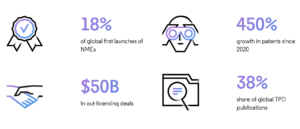
Resistance spurs revival of antibiotics in Europe
When penicillin was discovered by Dr. Alexander Fleming in 1928, people around the world believed it was one of the greatest medical and scientific advances in the history of mankind and they were right. Before penicillin, a bacterial infection in a minor cut or injury could easily become fatal. Diseases like scarlet fever, pneumonia, meningitis and diphtheria were essentially untreatable.
In the following decades, more antibiotics appeared on the scene, among them tetracyclines, isoniazid, macrolides, glycopeptides and cephalosporins.
Doctors began to routinely prescribe anti-biotics even when they weren’t sure that patients actually had bacterial infections and it seemed that this miracle of modern medicine had the potential to eradicate one of mankind’s tiniest but deadliest enemies.
Ominous data began to appear, however, suggesting that the miracle wouldn’t last forever. In the early 1980s, Staphylococcus aureus infections appeared that were resistant to mul-tiple antibiotics. At the same time, mul-tiple drug resistant Streptococcus pneuomoniae infections also surfaced.
Each passing year carried more troubling findings and an expanding list of bacteria that challenged even the most powerful antibiotics. Methicillin-resistant Staphylococcus aureus (MRSA) outbreaks in hospitals became headline news. More than 1.5 million people around the world are now dying each year from bacterial infections.
What happened to change bacterial infections from a health problem once considered by many to be nearly solved into an implacable foe described by a leading scientist as a catastrophe equal to bioterrorism?
Although pharmaceutical research into anti-biotics continues, a discovery void has emerged. Since 1987, the number of new antibiotics reaching the market has stalled. Meanwhile, new resistance mechanisms in bacteria have emerged, making even the most advanced antibiotics virtually ineffective.
Fearing that widespread resistance to anti-biotics could bring the end of modern medicine as we know it, the World Health Organization has made finding new, effective antibiotics one of its top three priorities, and regulatory authorities now offer incentives related to the research and development of new anti-bacterials.
In November 2013, Roche pRED (Pharma Research and Early Development) entered a partnering deal to develop novel anti-biotic POL7080, a Phase II compound targeting Pseudomonas aeruginosa (PA), a Gram–negative bacterial species causing severe infections. PA is responsible for a significant percentage of multi-drug resistant pneumonias in the hospital setting.
Encouraged by changes in the regulatory landscape and a better understanding of the under-lying biology, Roche is one of just a few companies that have so far returned to the development of antibiotics, determined to take on this threat to global health. Roche was an industry leader with Bactrim and Rocephin, two groundbreaking antibiotics credited with saving billions of lives, and the new focus on pathogen-specific drugs for multi-drug resistant bacteria plays on our legacy and our strengths.
For patients who are under siege by a microscopic enemy that seems to ward off all weapons, there is hope on the horizon.
Janet Hammond
is Head of Infectious Diseases at Roche Pharma Research and Early Development. She received her medical training at the University of Cape Town before specialising in internal medicine and pulmonary/critical care medicine. She then moved to the US, where she completed her fellowship in Infectious Disease at Duke University and Infectious Disease and Clinical Pharmacology at Johns Hopkins University. Prior to joining Roche in 2011, Dr. Hammond was Chief Medical Officer at Valeant Pharmaceuticals.


 White House
White House Clarivate
Clarivate H. Zell - wikipedia.org
H. Zell - wikipedia.org